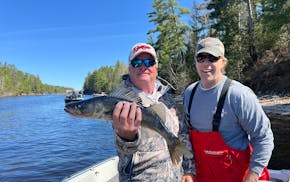Smoke that enveloped the state recently from forests burning along the Ontario border was an inconvenience to most Minnesotans and a health threat, albeit generally a minor one, to a relatively few.
Most media reports blamed the obscured views on the region's drought, adding that with a little luck, cool, wet weather will arrive soon to douse the northern flames so we can all get back to doing what we do in summer: play outside.
Yet in the same smoke, hidden in plain view, was another story about the historical role fire has played in developing the state's ecosystems, particularly those of the Boundary Waters Canoe Area Wilderness and its adjacent Canadian counterpart, Quetico Provincial Park.
Both need periodic regeneration by fire to exist as the aesthetic showpieces we have come to appreciate, with towering white and red pines, and voluminous stands of jack pines, among other tree species.
Among the first foresters to document the critical function fire has played along the state's northern border, including in what is now Voyageurs National Park, was Miron "Bud'' Heinselman (1920-1993).
In the 1960s and '70s, Heinselman, a U.S. Forest Service forest ecologist, pushed to end logging in the boundary waters and helped pass the 1978 BWCA bill that enlarged the wilderness while further restricting motorized access and ending timber harvesting.
Heinselman's research argued that only through wilderness designation of the boundary waters, complete with prescriptive fire management, could the area be sustained with its historical mix of trees, plants and wildlife.
"To understand the dynamics of fire-dependent ecosystems, fire must be studied as an integral part of the system,'' Heinselman wrote in 1973. "The search for stable communities that might develop without fire is futile and avoids the real challenge of understanding nature on her own terms.''
Heinselman retired early from the Forest Service, in part because he was frustrated by the agency's fire management policies that advocated for suppression as quickly as possible.
Those strategies have since been replaced by "more nuanced'' views of the potentially positive forest management roles fire can play, said Forest Service employee and Superior National Forest archaeologist Lee Johnson.
But implementation is easier said than done.
"I don't think there's anyone in the Forest Service today who doesn't look at fire as an ecological driver,'' Johnson said. "The hard parts are the competing interests, such as recreation and the economy. The urban interface, or homes and towns that surround these areas, also present challenges to forest management using fire.''
Paul Lundgren, Department of Natural Resources wildfire section manager, said his agency works closely with the Forest Service, and the DNR has firefighters alongside Forest Service firefighters in the BWCA now.
The Forest Service takes the lead on BWCA forest management by fire, Lundgren said. But droughts of the magnitude Minnesota faces this summer present few opportunities, if any, to prescriptively manage by fire.
"If we could see the future and know that a fire is going to stop at a certain time and place, great,'' he said. "But we don't know that and can't. We have to look way beyond a fire that is currently burning and imagine where it could go and how fast if weather conditions change.''
Lane Johnson, a forest researcher at the U's Cloquet Forestry Center in Cloquet, Minn., said the public's only nominal understanding of fire's role in the evolution of the boundary waters limits the Forest Service's options to manage with fire
Johnson cited as an example the smoke that blanketed the state on recent days. It was widely regarded as a nuisance and reported as such by the media, Johnson noted, rather than as a natural part of an ecological process.
"If you love the red and white pine forests of the boundary waters, if you're a fan of moose or if you like picking blueberries, then, whether you know it or not, you're a fire lover,'' Johnson said. "It can be difficult to see change on the landscape after a fire. But there is beauty in the burn. It's time to change our perspective and appreciate that.''
Quetico fire management this summer provides a study in contrasts to BWCA fire management, Johnson said. In part because of a lack of fire-fighting resources, but not exclusively for that reason, the Ontario Ministry of Natural Resources and Forestry, and Ontario Parks, are allowing fires to burn in the Quetico, regenerating its trees and plants using time-honored natural processes.
Research recently published by Johnson and others suggests that even native peoples inhabiting the boundary waters before 1900 used fire to clear trails and other sites and perhaps regenerate certain plants.
"Ironically,'' the study says, "protections granted by the 1964 Wilderness Act are resulting in a decline of the red pine forests once used to help justify establishment of the BWCA.''
Heinselman's research showed that almost all of the l-million-acre BWCA virgin forest area he studied was burned one to several times in the 377-year period, 1595 to 1972.
Only by replicating those fire events, to the degree possible, can the area be sustained in its present form, Johnson said.
"If we keep putting these fires out, eventually you're going to lose the seed sources for red and white pine,'' Johnson said. "It makes sense to allow fires to burn when and where we can to create the disturbance the forest needs. Everything is tied together, and just about everything in the boundary waters region is dependent on fire.''

Anderson: In early June, Minnesota fish are begging to be caught. Won't you help?

Anderson: Tails wagging, DNR officers' dogs find lost people and missing evidence
Anderson: Punish poachers more
Anderson: The Chainsaw Sisters Saloon is gone, but the Echo Trail is still a pathway to possibilities


